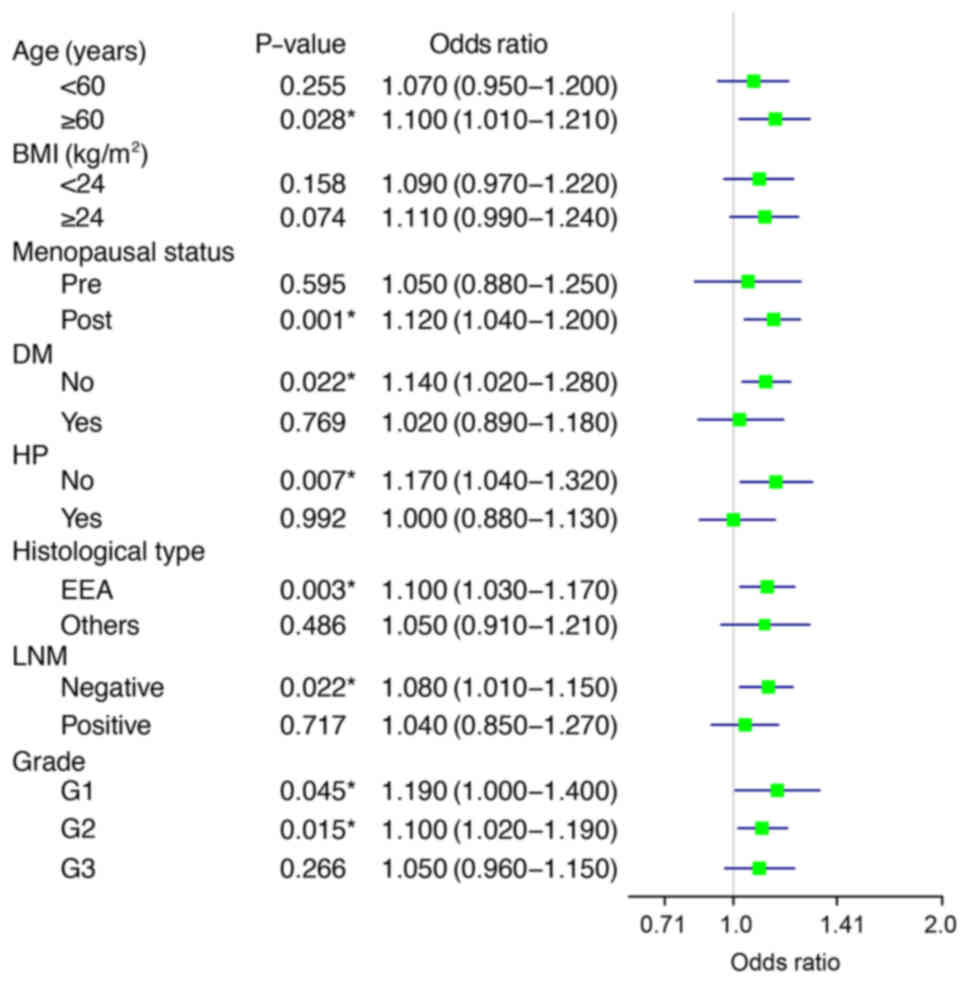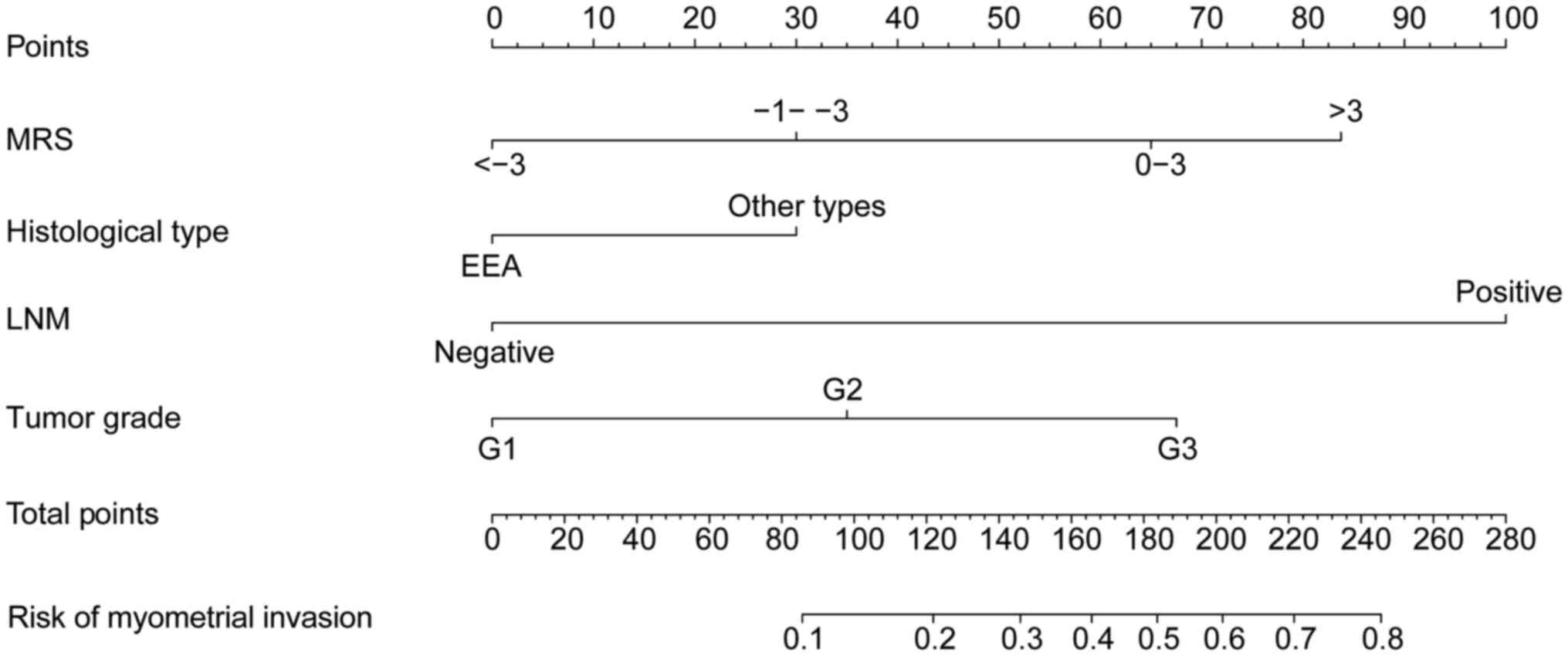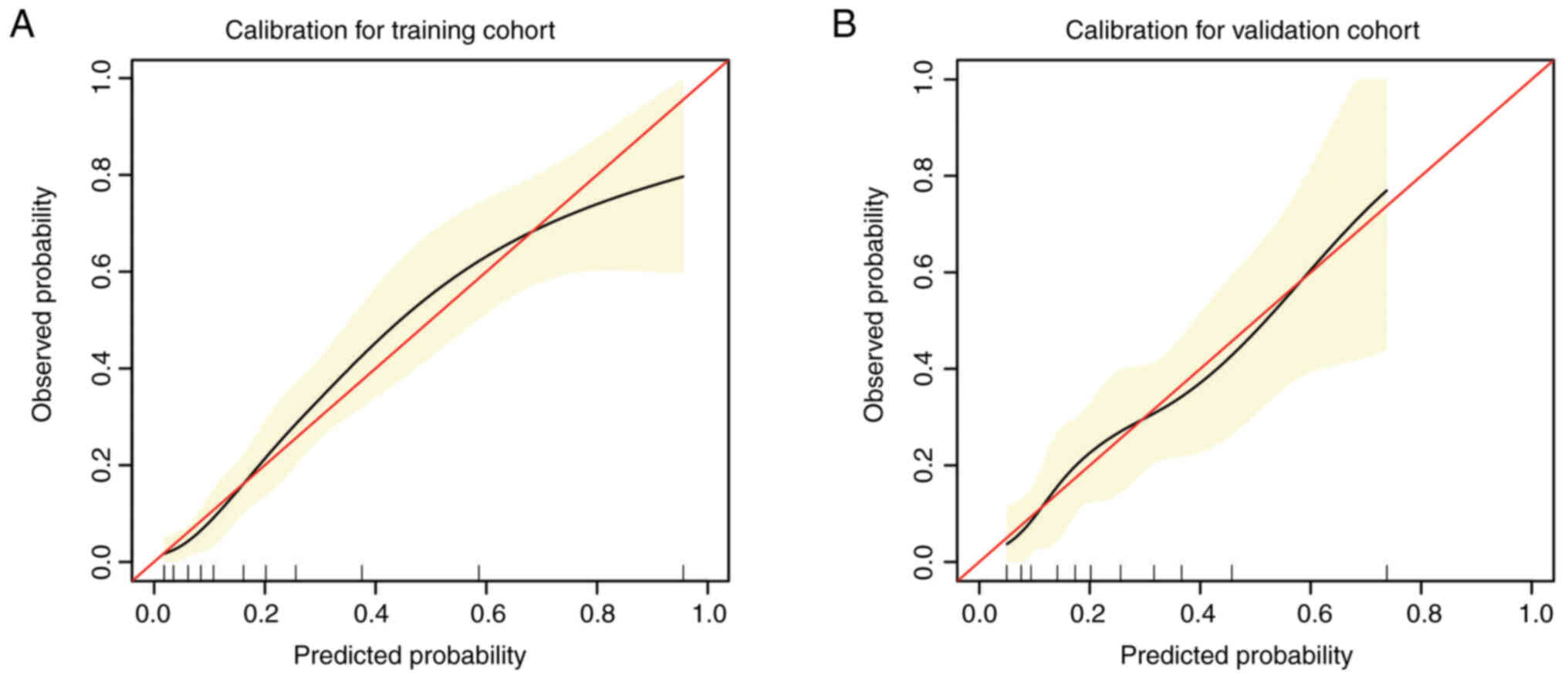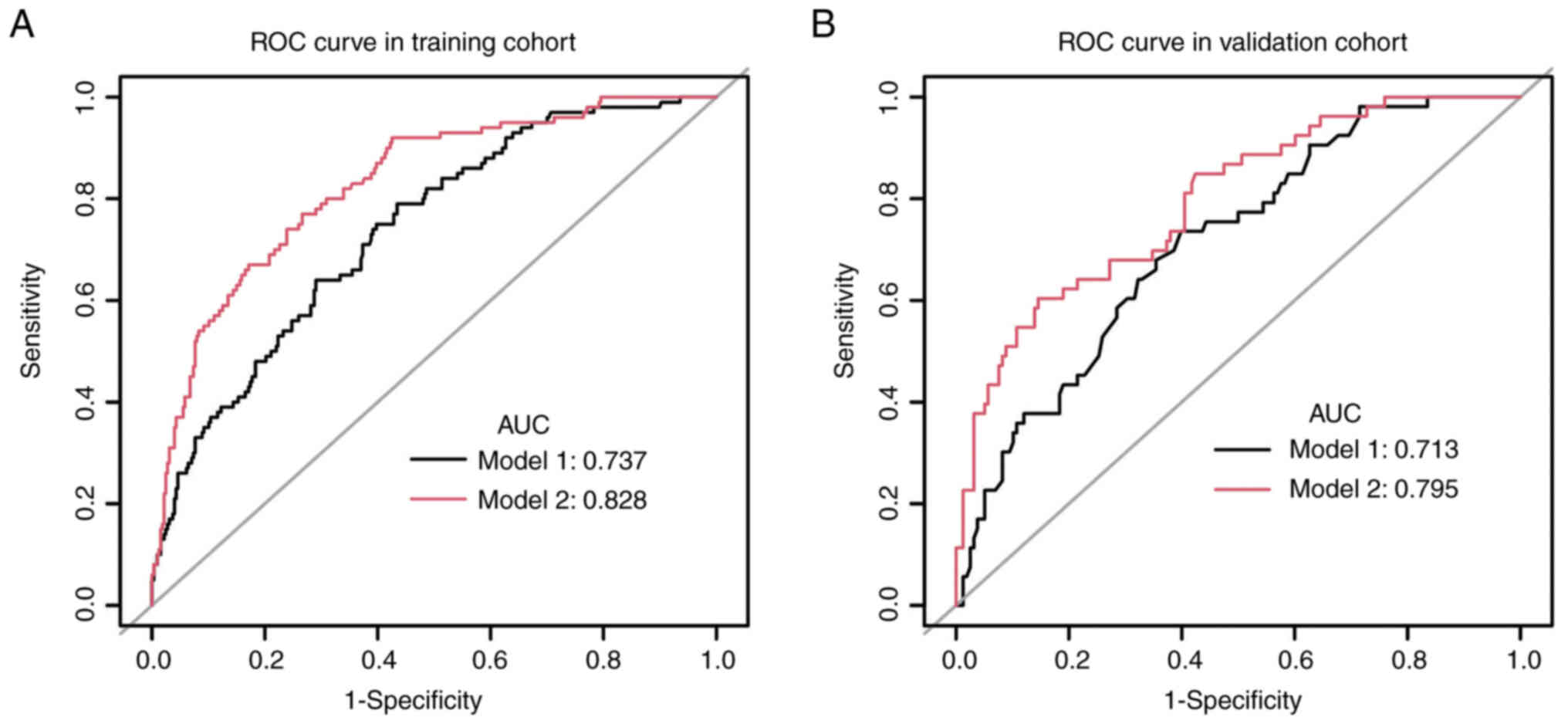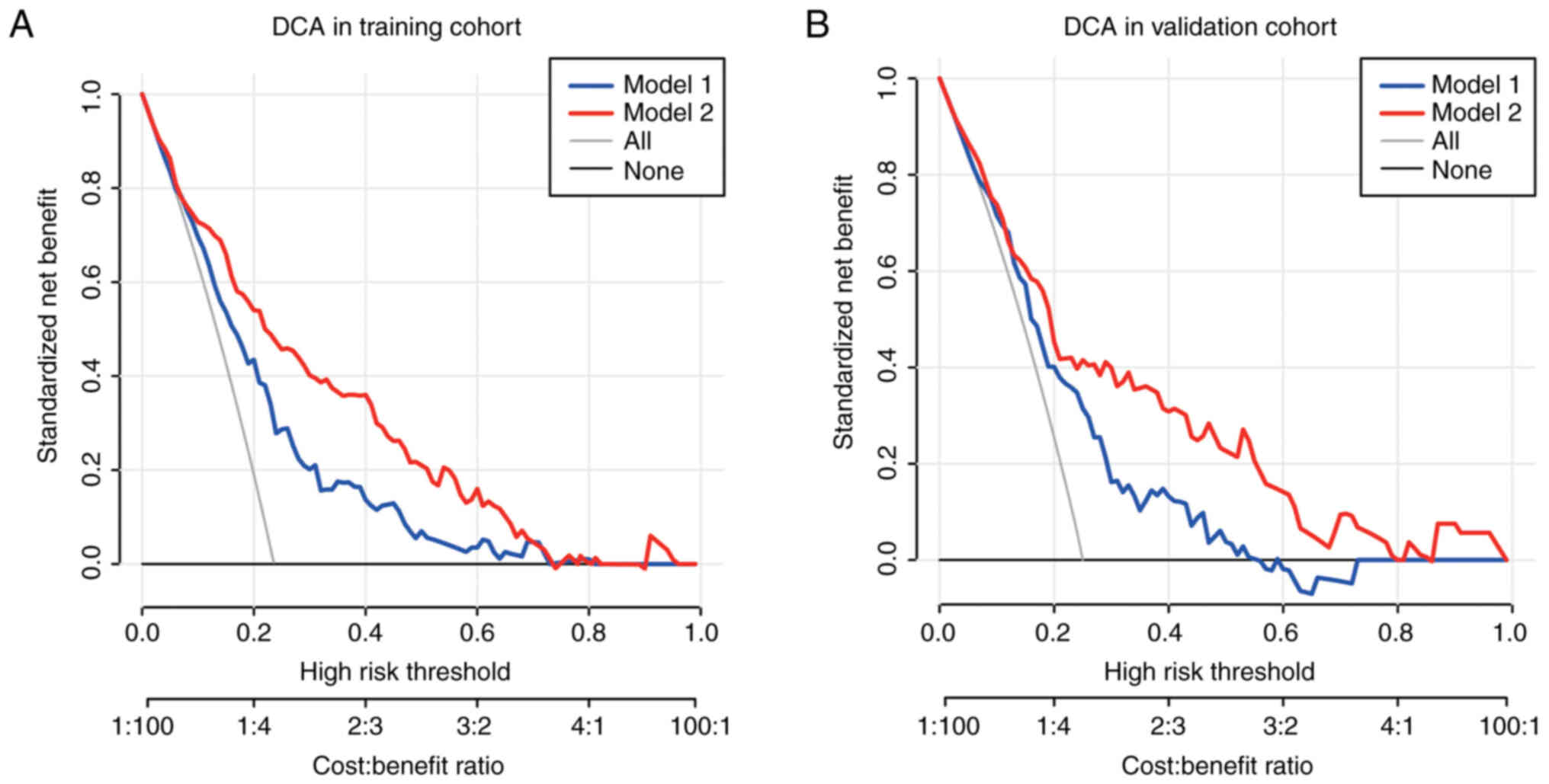|
1
|
Zhang S, Gong TT, Liu FH, Jiang YT, Sun H,
Ma XX, Zhao YH and Wu QJ: Global, regional, and national burden of
endometrial cancer, 1990–2017: Results from the global burden of
disease study, 2017. Front Oncol. 9:14402019. View Article : Google Scholar : PubMed/NCBI
|
|
2
|
Morice P, Leary A, Creutzberg C,
Abu-Rustum N and Darai E: Endometrial cancer. Lancet.
387:1094–1108. 2016. View Article : Google Scholar : PubMed/NCBI
|
|
3
|
Yang XG, Feng JT, Wang F, He X, Zhang H,
Yang L, Zhang HR and Hu YC: Development and validation of a
prognostic nomogram for the overall survival of patients living
with spinal metastases. J Neurooncol. 145:167–176. 2019. View Article : Google Scholar : PubMed/NCBI
|
|
4
|
Wu J, Zhang H, Li L, Hu M, Chen L, Xu B
and Song Q: A nomogram for predicting overall survival in patients
with low-grade endometrial stromal sarcoma: A population-based
analysis. Cancer Commun (Lond). 40:301–312. 2020. View Article : Google Scholar : PubMed/NCBI
|
|
5
|
Dong Y, Cheng Y, Tian W, Zhang H, Wang Z,
Li X, Shan B, Ren Y, Wei L, Wang H and Wang J: An Externally
validated nomogram for predicting lymph node metastasis of presumed
Stage I and II endometrial cancer. Front Oncol. 9:12182019.
View Article : Google Scholar : PubMed/NCBI
|
|
6
|
Li X, Cheng Y, Dong Y, Zhou J, Wang Z, Li
X and Wang J: Development and validation of predictive model for
lymph node metastasis in endometrial cancer: A SEER analysis. Ann
Transl Med. 9:5382021. View Article : Google Scholar : PubMed/NCBI
|
|
7
|
Wang Y, Bi Q, Deng Y, Yang Z, Song Y, Wu Y
and Wu K: Development and validation of an MRI-based radiomics
nomogram for assessing deep myometrial invasion in early stage
endometrial adenocarcinoma. Acad Radiol. Jun 28–2022.doi:
10.1016/j.acra.2022.05.017 (Epub ahead of print). View Article : Google Scholar
|
|
8
|
Esposito K, Chiodini P, Colao A, Lenzi A
and Giugliano D: Metabolic syndrome and risk of cancer: A
systematic review and meta-analysis. Diabetes Care. 35:2402–2411.
2012. View Article : Google Scholar : PubMed/NCBI
|
|
9
|
Sha H, Hu D, Wu S, Peng F, Xu G, Fan G,
Lin X, Chen G, Liang B, Chen Y, et al: Baseline metabolic risk
score and postsurgical esophageal cancer-specific mortality: The
fujian prospective investigation of cancer (FIESTA) study. J
Cancer. 9:1173–1181. 2018. View Article : Google Scholar : PubMed/NCBI
|
|
10
|
Yang X, Li X, Dong Y, Fan Y, Cheng Y, Zhai
L, Zhang S, Zhou J and Wang J: Effects of metabolic syndrome and
its components on the prognosis of endometrial cancer. Front
Endocrinol (Lausanne). 12:7807692021. View Article : Google Scholar : PubMed/NCBI
|
|
11
|
Tibshirani R: The lasso method for
variable selection in the Cox model. Stat Med. 16:385–395. 1997.
View Article : Google Scholar : PubMed/NCBI
|
|
12
|
Ruz-Caracuel I, Ramon-Patino JL,
Lopez-Janeiro A, Yebenes L, Berjon A, Hernandez A, Gallego A,
Heredia-Soto V, Mendiola M, Redondo A, et al: Myoinvasive pattern
as a prognostic marker in Low-grade, early-stage endometrioid
endometrial carcinoma. Cancers (Basel). 11:18452019. View Article : Google Scholar : PubMed/NCBI
|
|
13
|
Shou H, Yan K, Song J, Zhao L, Zhang Y and
Ni J: Metabolic syndrome affects the long-term survival of patients
with non-endometrioid carcinoma of the uterine corpus. Int J
Gynaecol Obstet. 148:96–101. 2020. View Article : Google Scholar : PubMed/NCBI
|
|
14
|
Matoba Y, Yamagami W, Chiyoda T, Kobayashi
Y, Tominaga E, Banno K and Aoki D: Characteristics and
clinicopathological features of patients with ovarian metastasis of
endometrial cancer: A retrospective study. J Obstet Gynaecol.
42:2456–2462. 2022. View Article : Google Scholar : PubMed/NCBI
|
|
15
|
Maire M, Bourdon A, Soubeyran I, Lucchesi
C, Guyon F, Babin G, Floquet A, Petit A, Baud J, Velasco V, et al:
Biomarkers associated with lymph nodal metastasis in endometrioid
endometrial carcinoma. Cancers (Basel). 14:21882022. View Article : Google Scholar : PubMed/NCBI
|
|
16
|
Omiyale W, Allen NE and Sweetland S: Body
size, body composition and endometrial cancer risk among
postmenopausal women in UK Biobank. Int J Cancer. 147:2405–2415.
2020. View Article : Google Scholar : PubMed/NCBI
|
|
17
|
Zhao M, Wen F, Shi J, Song J, Zhao J, Song
Q, Lai Q, Luo Y, Yu T, Jiang X, et al: MRI-based radiomics nomogram
for the preoperative prediction of deep myometrial invasion of FIGO
stage I endometrial carcinoma. Med Phys. 49:6505–6516. 2022.
View Article : Google Scholar : PubMed/NCBI
|
|
18
|
Tong Y, Huang M, Chen L, Lei H, Lin H, Mao
X and Sun P: ERRgamma, a novel biomarker, associates with
pathoglycemia of endometrial cancer to predict myometrial invasion.
J Oncol. 2022:52833882022. View Article : Google Scholar : PubMed/NCBI
|
|
19
|
Luo YZ, Yang Z, Qiu YL, Li XH, Qin LQ, Su
QS and Mo WN: Pretreatment triglycerides-to-high density
lipoprotein cholesterol ratio in postmenopausal women with
endometrial cancer. Kaohsiung J Med Sci. 35:303–309. 2019.
View Article : Google Scholar : PubMed/NCBI
|
|
20
|
Borden LE, Locklear TM, Grider DJ, Osborne
JL, Saks EJ, Valea FA and Iglesias DA: Endometrial Cancer
Characteristics and Risk of Recurrence. Am J Clin Pathol.
157:90–97. 2022. View Article : Google Scholar : PubMed/NCBI
|
|
21
|
Bacalbasa N, Diaconu C, Iliescu L, Savu C,
Savu C, Balalau C, Dimitriu M, Filipescu A, Bratu OG, Neacsu A, et
al: The Influence of the metabolic syndrome on early postoperative
outcomes of patients with advanced-stage endometrial cancer. In
Vivo. 34:2913–2917. 2020. View Article : Google Scholar : PubMed/NCBI
|
|
22
|
Andrade Fernandes JP, da Camara AO,
Frajacomo FT, Chaves CBP, Fernandes Pereira A and Chaves GV:
Metabolic profile of patients with endometrial adenocarcinoma and
association with tumor grade. Int J Gynecol Cancer. 32:626–632.
2022. View Article : Google Scholar : PubMed/NCBI
|















